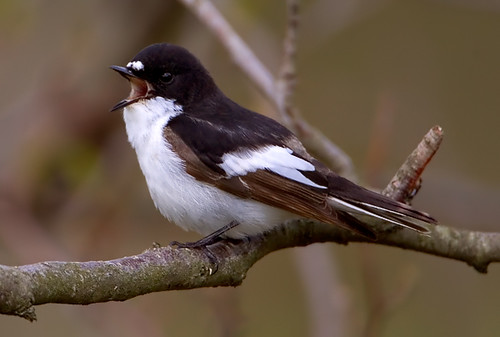tags: researchblogging.org, reciprocal altruism, cooperation, anti-predator behavior, mobbing, birds, pied flycatcher, Ficedula hypoleuca, Indrikis Krams
Male European pied flycatcher, Ficedula hypoleuca, singing.
Skåne, Sweden.
Image: Omar Brännström, 8 May 2005 [link].
Canon EOS 1D Mark II ,Canon EF 500mm f/4L IS USM 1/640s f/5.6 at 700.0mm iso320.
Meticulous experimental design is crucial to understanding the evolution of specific behaviors, expecially complex and subtle behaviors exhibited by highly intelligent and very social animals, such as birds. One such behavior is mobbing behavior; when a group of genetically unrelated but closely located individuals join together to drive away a much larger predator.
Many animals rely on this evolved behavior to protect their offspring, and they have a variety of stereotyped behaviors and vocalizations that alert neighbors -- both conspecifics and heterospecifics -- to join in the fray. This survival strategy has given rise to two choices that are known to game theorists as the "iterated prisoner's dilemma": either to cooperate by joining in the mobbing behavior or to defect by not joining.
Birds on neighboring territories are more likely to benefit from joint mobbing efforts to drive potential predators away from their nests whereas a single bird mounting an attack on a predator faces an increased risk to itself while a defector does not encounter any increased risks. There are several methods for dealing with defectors in the "iterated prisoner's dilemma", but the most simple strategy is a tit-for-tat model of cooperative behavior. This model shows an initial bias for cooperative behavior where each individual involved then copies what the other individuals did previously. If a bird helps its neighbor to repel a potential predator, then that bird's neighbor will reciprocate in its time of need, and both benefit by having a larger group defending their nests. However, if a bird ignores its neighbor's calls for help, that bird should find itself unaided the next time that it calls for help.
But how can one learn if tit-for-tat is the behavioral strategy employed by birds? A group of field ornithologists from the University of Daugavpils in Latvia and the University of Tartu in Estonia collaborated to answer this question in European pied flycatchers, Ficedula hypoleuca. Pied flycatchers are small Old World passerines that are fairly common throughout Europe and Asia. They are, as their name implies, insectivores. These migratory birds arrive early on their breeding territories in spring and nest either in holes in trees or in open-fronted nestboxes -- a feature that makes them easy to momitor and thus, makes them wonderful research birds.
To do this study, the scientists mounted 300 nestboxes so that trios of nestboxes would be in close proximity, and each nestbox in the trio was randomly assigned an identifying letter of A, B, or C. The scientists marked each pair of birds by placing foam rubber saturated with washable ink in the nestbox entry holes 1-2 days prior to the beginning of the experiment, so the birds marked themselves as they came and went through the nestbox entrance hole to feed their chicks. Since pied flycatchers are sexually dichromatic, each member of a breeding pair was easily identified as well.
Phase one of this experiment occurred when the researchers placed a stuffed tawny owl, Strix aluco, 1-1.5 meters away from nestbox A. Meanwhile, the pair of birds that occupied nestbox B had been secretly captured and were thus unable to participate in the ensuing mobbing behavior, whereas the pair of birds that occupied nestbox C were free to participate, and all the birds' behaviors were observed.
Phase two occurred one hour after the stuffed owl had been removed from the vicinity of nestbox A, and the captured "B" pair of birds had been released. The researchers placed a stuffed owl near to nestboxes B and C, and then they observed the behavior of the A pair of birds: would they assist pair B -- the "defectors" -- or pair C, the cooperators, or would they ignore both pairs? Overwhelmingly, pair A assisted pair C and ignored pair B's pleas for help (figure 1);
Figure 1: Number of the nestbox A pairs of pied flycatchers that assisted co-operators, assisted defectors and remained at their own nest during phase two of the primary experimental situation (n=32)
This experiment demonstrates a simple tit-for-tat behavior where defectors are punished for their lack of assistance, and cooperators are rewarded. But reciprocal altruism can only exist under very specific social circumstances where the animals involved interact repeatedly.
"A very important condition for reciprocity to evolve is that there must be repeated interactions between the participants, so failing to co-operate on one occasion has a penalty in the future through not having the co-operative act reciprocated next time," write the authors. "For this reason, such behaviours as mobbing are expected to be characteristic of animals that stay together over long periods of time, enough for the roles of donor and recipient to be exchanged many times."
Furthermore, the participants in this community must be able to recognize individuals and be able to remember their previous reactions so they can punish cheaters.
"In this experimental study, co-operating flycatcher families won the reward for mutual co-operation on every encounter. Non-co-operators were immediately punished," conclude the authors. "The results show that the origin and evolution of mobbing behavior of breeding pied flycatchers can be explained in terms of reciprocal altruism."
Source
Krams, I., Krama, T., Igaune, K., Mänd, R. (2008). Experimental evidence of reciprocal altruism in the pied flycatcher. Behavioral Ecology and Sociobiology, 62(4), 599-605. DOI: 10.1007/s00265-007-0484-1.
WHEATCROFT, D., PRICE, T. (2008). Reciprocal cooperation in avian mobbing: playing nice pays. Trends in Ecology & Evolution DOI: 10.1016/j.tree.2008.04.011.
- Log in to post comments


